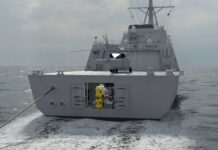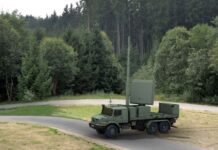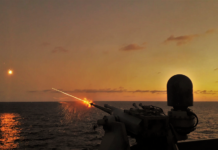The Australian Army is introducing the Hawkei Protected Mobility Vehicle – Light (PMV-L) to replace one third of the services’ legacy Land Rovers with a more modern and survivable platform. The procurement program for 1,100 vehicles and 1,058 associated trailers is designated LAND 121 Phase 4.

Credit: Australian DoD
The Hawkei vehicle is domestically designed and built by Thales Australia. The production facility is located in Bendigo, Victoria. Several major subcontractors have contributed to the Hawkei MVP-L program. Major subcontractors identified by the Department of Defence include:
- Albins Performance Transmissions, based in Ballarat, for the vehicle cross drive, steering rack, castings and shafts;
- Flexible Drive Agencies, based in Oakleigh, for the wiper and gear selector assembly;
- Thomas Warburton, based in Dandenong South, for fasteners and hardware; and
- Gough Transport Solutions, based in Noble Park, for the pneumatic system;
- Plasan, which designed and manufactured the passenger cabin as well as providing the Super Multi-hit Armor Technology (SMART) scalable protection system.
The 5.7 m long, 7 tonne Hawkei 4×4 is offered in two variants. The four-door variant can be outfitted for command, liaison and reconnaissance missions; more recent discussion has opened the possibility of employing the PMV-L in the light fighting role as well. The four-door vehicle seats five soldiers and can be outfitted with a variety of weapon mounts. The two-door utility variant seats three, and features a flatbed which can accommodate cargo or various mission systems, including weapons or containerised mission modules. The vehicle’s payload capacity is 3 tonnes. Either variant can also tow the specially designed 4 tonne capacity single-axle trailer. The ADF procurement goal encompasses 635 four-door vehicles and 465 two-door vehicles.
A New Capability
The Australian government classifies the Hawkei PMV-L as a brand-new capability that will provide the Australian Defence Force (ADF) with a highly protected and deployable light vehicle fleet designed to provide an optimum balance of six fundamental requirements: survivability, mobility, useability, payload, sustainability and communications. The Hawkei is expected to and complement the existing – and much heavier – Bushmaster PMV – Medium to create a suite of protected mobility vehicles, whereby the PMV-Light will offer comparable protection but significantly enhanced mobility options versus the 12.5 tonne Bushmaster.
A Steyr M16 six-cylinder 200 kW twin-turbo diesel engine with 8-speed automatic transmission enables a maximum road speed of 115 km/h and a range in excess of 600 km without refuelling. The 4×4 drive with independent coil suspension and central tyre inflation system (CTIS) is designed to offer excellent off-road mobility over a wide range of terrain types. The vehicle can be transported internally via C-130 aircraft, and is the only Australian protected vehicle which can also be sling-loaded beneath a CH-47F helicopter.

Credit: Australian DoD
As the PMV designator suggests, the Hawkei is designed to operate in high-threat environments. The blast, ballistic and fragmentation protection is designed to defend against IEDs, mines and small arms fire. The basic armour which fortifies the crew capsule can be augmented by mission tailored add-on armour packages for the crew compartment and other parts of the vehicle.
Equipment
A portion of the four-door vehicle fleet will be equipped with the RS400 Mk2 remote weapons station (RWS) made by the Australian firm Electro-Optical solutions (EOS). In July 2020 the Australian MoD announced a contract for 251 of the RWSs, to be installed both on the new Hawkei as well as on the larger Bushmaster protected mobility vehicles which are already in service. Testing to ensure functionality of the RS 400 Mk 2 on the Hawkei had been conducted in 2018. The RWS can be integrated onto the Hawkei via the Integral Computing System. The Mk 2 RWS can mount a variety of weapons, with options including a 7.62 mm MG or 12.7 mm HMG, a 40 mm automatic grenade launcher (AGL), an M230 LF lightweight 30 mm automatic cannon, anti-tank guided missiles, as well as various sensors. According to EOS, “the first round hit probability is provided through an enhanced integrated ballistic solution which analyses weapon and ammunition data; range and ambient environment in addition to vehicle attitude and dynamics.” Optional video tracking of targets and multi-axis stabilisation can further enhance the engagement accuracy of RWS-mounted weapons. The 30 mm automatic cannon is especially notable, as it provides the 4×4 vehicle with firepower approaching that of some Infantry Fighting Vehicles (IFVs).

Credit: Australian DoD
The Chief of the Defence Force and former Chief of the Army, General Angus Campbell, has praised the Hawkei’s groundbreaking electronics suite.” It is the first vehicle that I am aware of – possibly the first vehicle in the world – that is built to be digitally wired in the same conceptual fashion as you see in the wiring of a modern aircraft glass cockpit,” Campbell said. “The loom of wiring and the computer systems that enable our combat system and radios to be applied is the first part of design of the vehicle, not the last add-on that you then have to spend a lot of time trying to integrate and reconfigure. It very much speaks to where we can be in the future with vehicle systems design and bringing a lot of the ideas that we see in air and naval platforms into ground combat vehicles.” The electronics suite permits the vehicle to be used as a command and control hub, linking via satellite with forces hundreds of kilometres away. At the heart of this networking capability is the Hawkei’s Integral Computing System (ICS) communications management system. At the micro-level, the ICS also integrates the on-board battle management systems, fire control and weapon-mount sensors into a common display for the vehicle crew. Finally, the ICS supports the automated Health and Usage Monitoring System which is eventually expected to enable conditions based rather than schedule based maintenance. The open architecture communications management system is configured to readily accept new electronic mission systems in the future, guaranteeing state of the art capabilities throughout the vehicle’s service life.
Setbacks Encountered
The Australian Department of Defence signed the Hawkei PMV production contract with Thales Australia on 5 October 2015. The sole-source contract’s original value was given as AUD 1.3 bn. Pilot production began in 2016 with an initial run of ten vehicles and five trailers to be evaluated during the Reliability Growth Trials (RGT) of the Engineering and Manufacturing Development stage (Program Stage 1); an additional six vehicles and four trailers were delivered for the reliability testing portion of the Low Rate Initial Production (LRIP) stage (Program Stage 2). The government began accepting vehicles under the LRIP program in January 2018 as testing continued. During the course of reliability testing, two vehicles were also deployed to Iraq and Afghanistan in early 2018 to test their sustainability overseas.

Credit: Boeing Defence Australia
While the deployment testing was concluded successfully, other aspects of early evaluation did not go as well. By January 2017, the pilot Hawkei vehicles had exceeded the seven critical failures allowed under the contract. These were attributed to supplier quality issues and immature components affecting hardware and software integration. While Thales implemented engineering upgrades to correct these issues, additional subsystem failures continued to appear, with several reliability issues remaining in late 2018.
The firm was able to assure the government that appropriate action was being taken, but the cumulative effect of the early reliability issues was to delay the original programme timeline. Full Rate Production (FRP) was originally slated to begin in 2018, with delivery of all contracted vehicles and trailers by the end of 2021. As it was, FRP was not approved until September of 2020 following successful completion of ballistic and blast testing. Only three months later, in December 2020, the Australian Department of Defence (DoD) suspended acceptance of vehicles following a 23 November 2020 safety incident involving the vehicle’s anti-lock braking system (ABS) while operating on a steep gradient. Operating restrictions were put in place for the nearly 100 vehicles which had already been delivered to the armed forces through LRIP.
Initial Operational Capability
The braking issue caused delays to four programme milestones while Thales engineers devised a technical solution. The resulting Brake Remediation Plan called for the fix to be applied across the Hawkei fleet by 2022, and was coupled with administrative measures put in place to prevent mishaps in the interim. The government agreed to this plan. On 11 July 2021 the then Minister for Defence Peter Dutton approved the Hawkei’s Initial Operational Capability (IOC), and set an expected Full Operational Capability target of 2023. Restrictions on acceptance of newly-built vehicles were lifted, as were the operational restrictions. In late 2021 the vehicles were publicly displayed in service with the newly reactivated 10th Light Horse Regiment. The Army also released photos of Hawkeis being deployed during early 2022 flood relief operations.

Credit: Australian DoD
Construction of the contracted vehicles continued apace. The thousandth PMV-L rolled of the assembly line at Bendigo in March of 2022, and was formally presented to Major General Simon Stuart, Head of Land Capability (responsible for army acquisition programs). As the firm informed the Australian Broadcasting Corporation (ABC), several hundred vehicles were already being operated by the Army throughout Australia by that time. The complete outstanding production run was expected to be ready for delivery to the ADF by June 2023, following outfitting and quality control testing.
Fielding and FOC
Once again, however, the Land 121 Phase 4 program has been forced to adjust its timeplan. The Australian National Auditor General’s 2021-2022 Defence Major Projects Report, completed in February 2023, summarised the Hawkei programme’s various initial challenges meeting FRP, which were subsequently exacerbated by COVID-related supply chain disruptions. These events had a cascading effect, delaying ADF training cycles for the new vehicles.
Additionally, Thales informed the Defence Department on 11 November 2022 that it had discovered a new issue with the braking system. According to the firm, discovery of the new problem was not related to a safety incident, but occurred during routine quality control inspections at the Bendigo plant. The Auditor General’s office concluded that the current issue is not related to the earlier defect involving the ABS system, for which a technical solution is still being implemented. As of February 2023 the cause of the issue – the precise nature of which has not been made public – was still under investigation. As of mid-April, neither Thales nor the Australian government have announced a resolution to this latest issue. The ADF has restricted operations of the Hawkei until the investigation is concluded and a remedy is identified.

Credit: Australian DoD
According to the Auditor General’s report, the cumulative effect of these past and recent difficulties is a delay of the Full Operational Capability target from June 2023 to June 2024. The Defence Major Projects Report further shows that the budget approval for the Land 121 Phase 4 now stands at AUD 1.963 bn.
Export Options
In addition to fielding the PMV-L as a high-performance tactical asset for its own armed forces, the Australian government hopes to export the Hawkei, with the dual goal of enhancing the nation’s security partnerships and benefiting Australian-based industry. As early as October 2017 the then-defence minister, Christopher Pyne, travelled to Poland to support Thales’ bid to export the Hawkei. More recently, a Hawkei was delivered to Japan in 2022 for testing as a potential replacement for the Japanese Ground Self Defence Forces Light Armoured Vehicles.
However, such opportunities will not materialize until the PMV achieves FOC status with the ADF. The braking issue has been cited as the reason for Canberra’s reluctance to provide Hawkei PMVs to Ukraine following the Russian invasion. As late as mid-April 2023 the Albanese government continues to maintain the position that the vehicles cannot be exported until they are cleared for FOC in Australia.
Retired Australian Army Brigadier Ian Langford concluded on 6 April 2023 that the Hawkeis were “on the road” to FOC certification. Langford, who served as acting Head of Land Capability in 2018-2019 and again in 2022, continued: “But like all major programs, when they come into service they always have teething problems, and they are working through that (…) Australia sets a pretty high standard for the safety conduct of these sorts of machines.” In the long term there should be no obstacles to exports.

Credit: Australian DoD
This of course is predicated on Thales retaining a viable production line. The firm has confirmed that the last of the 1,100 contracted vehicles rolled off the assembly line in July 2022, and are in various stages of outfitting and quality control testing. Australian press reports from mid-2022 cite the beginning of layoffs at the Bendigo plant. A Thales spokesperson told ABC in August 2022 that the firm was pursuing export orders for both the Hawkei and the Bushmaster (which is also manufactured at the Bendigo plant) to generate job growth on site. Lisa Chesters, the Member of Parliament representing Bendigo, warned that the factory was at risk of closure if Thales failed to secure additional defence contracts. She confirmed that discussions regarding future projects were underway between the government and the firm. “The minister and the army are in discussions with Thales about the next projects for the site. But these contracts don’t get signed overnight,” Chester told the ABC on 24 August 2022. To date, no new contracts have been announced.
Sidney E. Dean












